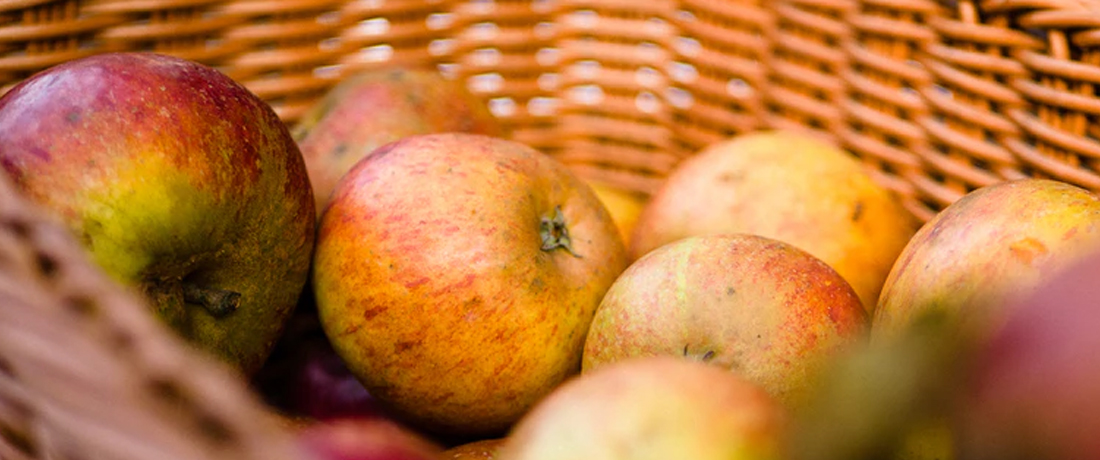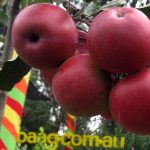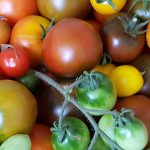
 Important note about plant availability. Important note about plant availability.There are hundreds of factsheets on our website provided for your information. Not all plants will be available at all times throughout the year. To confirm availability please call (03) 8850 3030 and ask for the nursery. |
The past decade has seen a wide recognition of the benefits and qualities of heritage and non-commercially grown fruit and vegetable varieties.
Commercially grown fruit and vegetables must have certain qualities such as uniformity, ease of harvesting, good travel and storage qualities all of which can be ignored by the home gardener. There is no need to compromise on flavour, texture, colour, aroma and fun when you grow your own. Heritage varieties have been around for centuries because people have enjoyed eating them, with the less appealing varieties disappearing over time. The end result is some simply stunning varieties to chose from, often with wonderful quirky characteristics. There are new cultivars being developed or found (nature did the work) by dedicated gardeners and horticulturalists all the time.
There is great charm and satisfaction in understanding, growing and eating fruit from your own garden. Researching the history of the variety, appreciating its specific qualities and how and when to eat it, all deepen the indefinable enjoyment of sharing the fruit from your garden with family and friends.
A more pragmatic reason for maintaining our heirloom varieties is genetic diversity and the knowledge that once a variety is extinct, it is unavailable for any future use and any potential benefits lost forever.
Worldwide there are thousands of heritage fruit varieties. In Australia there are far fewer, but still many to choose from. At BAAG, we are developing our range of heritage and uncommon varieties, trying to pick ones which will do well in Melbourne / Victoria and are both interesting and useful.
In addition to the Heritage Apples listed here, we also keep a large range of Modern Apple Trees.
Apple – Alexander – Heritage Apple
Pollinators: Lord Lambourne, McIntosh, Tydeman’s Early Worcester, Cox’s Orange Pippin, Granny Smith, Jonathan, Sturmer, Polka, Waltz, Gala, Golden Delicious. Duke of Clarence
Maturity – February March
Brilliant orange and red broad stripes over pale yellow background, this large apple is both a good (sharp) eating and good cooking apple, cooking up to a lovely lemony puree.
18th Century from Ukraine . Growers around Riga, on the Baltic, sent fruit every year to the Russian Court and named the apple as a compliment to Emperor Alexander
Popular also because of its hardiness and heavy regular bearing.
Apple – Court Pendu Plat
Pollinators: Mid to late season apples such as Pomme De Neige, Golden Delicious, Granny Smith, Cox’s Orange Pippin or Jonathan.
Ripens late season
This is considered the oldest apple known, introduced into Europe in Roman times. Small in size, yellow skin flushed with orange and red, sometimes russet. Brisk acid flavour when first picked, mellowing to sweet and fully flavoured as it matures. Flowers late (avoids frost) and just superb considering it’s about 1500 years old!
The flesh is very dense, not soft but not crisp either. Cutting into it with a knife feels a bit like cutting into a hard cheddar cheese. There seems to be very little juice, and it is not really apple-flavoured at all. The flavour is fruity and strong when picked, and sweetens as it ages. It is not actually very appealing when you first bite into it, yet is strangely “more-ish”, with a flavour which is hard to define. It can also be used for cooking.
Apple – Devonshire Quarrenden – Heritage
Pollinators: partially self-fertile, Vista Bella, Lord Lambourne, McIntosh, Alexander, Cox’s Orange Pippin, Granny Smith, Jonathan, Sturmer, Tydeman’s Early Worcester, Polka, Waltz.
Maturity Jan – February
1670 from Devon
Devonshire Quarrenden produces beautiful small crimson red apples with sweet, crisp and juicy flesh and an aromatic strawberry-like flavour. This flavour can depend on time of picking and be elusive, but is distinctive and pronounced at certain times. The red skin can bleed into the flesh and occasionally red flecks may appear within the flesh. Cooks well.
Will often tolerate quite wet and windy sites.
However, there are some caveats. Like all early apples Devonshire Quarrendon does not keep.
Apple – Duke of Clarence
Maturity: June July
Lord Lambourne, McIntosh, Tydeman’s Early Worcester, Cox’s Orange Pippin, Granny Smith, Jonathan, Freyberg, Polka, Waltz, Gala, Golden Delicious.
Another outstanding apple that seems to have dropped out of sight. A gloriously beautiful apple polishing to a glossy dark burgundy. A lovely medium round shape with creamy pale flesh accompanied by an outstanding sweet apple flavour. Will grow well in Melbourne conditions and takes the apple season well into winter. This apple was widely grown in Tasmania, but has gradually been lost to sight. The only way to get one is to grow one.
Apple – Fenouillet Gris – Heritage
Maturity: March to April
Vista Bella, Devonshire Quarrenden, Lord Lambourne, Alexander, Cox’s Orange Pippin, Granny Smith, Jonathan, McIntosh, Sturmer, Tydeman’s Early Worcester, Polka, Waltz.
Long esteemed in France and one of ‘seven principle apples’ grown by La Quintinye at Versailles, it is first recorded in France in 1608 when described as Espice D’Hiver, listed by Olivier de Serre. The word Fenouillet means fennel, of which the apple’s flavour is said to be reminiscent. It is a dessert apple but has also been used for cider. A blocky shape with golden yellow skin nearly covered with brown russet, with a greyish brown tinge on the sunny side. Not one to highlight in the fruit bowl. The yellowish flesh is rich, tender, crisp and sugary with a fine aromatic flavour, it is this that has kept the apple going for the past 4 centuries and more. This is a collector’s apple.
Apple – Freyberg
Matures: April
Lord Lambourne, McIntosh, Tydeman’s Early Worcester, Cox’s Orange Pippin, Granny Smith, Jonathan, Sturmer, Polka, Waltz, Gala, Golden Delicious. Duke of Clarence
An amazing apple, drawing qualities from both it’s parents – Golden Delicious and Cox’s Orange Pippin. Nicely shaped medium sized fruit, the skin a lovely golden green with a tiny russet fleck. It ripens midseason and hangs well on the tree. The juicy white crisp flesh has an almost spicy flavour and with just a hint of anise, can also have distinct pear like overtones, it continues to develop flavour when ripe. Very memorable and a favourite of everyone that tries it. One of our favourites.
A good keeping apple as well as a reliable tree and fairly easy to grow. Rarely available for sale, so you will have to grow your own!
Apple – Huonville Crab
Pollinators: Mid to late season apples such as Pomme De Neige, Golden Delicious, Granny Smith, Cox’s Orange Pippin or Jonathan.
Because of their prolific flowering, crab apples are regarded as great pollinators for apples. Ripens April to May
Discovered in Huonville, Tasmania, producing deep scarlet apples which have deep pink flesh right to the core. The leaves of the tree are purple, as is the stem. Probably a hybrid between a crab apple and a cultivated apple, resulting in the small fruit (bigger than crab apples). It would also explain it’s vigour and prolific bearing. Great to eat, great cooked or juiced and makes a very acceptable cider.
Apple – Lord Lambourne
Maturity March-April
Pollinators: Considered to be self pollinating, but pollinators may increase fruit set:Vista Bella, Devonshire Quarrenden, McIntosh, Alexander, Cox’s Orange Pippin, Granny Smith, Jonathan, Sturmer, Tydeman’s Early Worcester, Polka, Waltz. Freyberg
Introduced in 1907 and is very much in the tradition of classic English high-quality aromatic dessert apples. It has the pleasing uniform shape – round, and not too flattened – and typical orange flush over green, with a hint of russet. The flesh is creamy-white and quite crisp, and the flavour is pleasantly strong with good depth and subtlety. Excellent juice and acidity. Considered as good as Cox’s Orange Pippin, and much easier to grow, less disease prone.
Like many of the aromatic apples, Lord Lambourne is a very good juicer.
Apple – McIntosh – Heritage
Partially self fertile:
Vista Bella, Devonshire Quarrenden, Lord Lambourne, Alexander, Cox’s Orange Pippin, Granny Smith, Jonathan, Sturmer, Tydeman’s Early Worcester, Polka, Waltz.
Matures march – April
One of the great North American varieties originating in Ontario around 1800
A small to medium bright red apple, roundish shaped that fits gently into the hand, with a bit of stripe or fleck in the colouring. It has sweet scented white flesh, occasionally with pink streaks. The flavour is simple and direct, generally sweet with a refreshing acidity and usually a hint of wine – a McIntosh at its peak straight from the tree is a culinary experience to savour.
The fruit grows best in cool areas where nights are cold and autumn days are clear. Heavy and reliable cropper, with best flavour in colder regions.
Apple – Opalescent
Cross pollinators: Granny Smith, Cox’s Orange Pippin, Sturmer Pippin, Lord lambourne, Fuji, Golden Delicious, Gala.
An American antique apple (c. 1880) of immense worth. Big, aromatic, primarily dark glowing crimson red and hefty. A fine and satisfying apple, a mildly tart and sweet crunchy stunner. Cooks superbly. Has been around for 130years and will be around for much longer, a great addition to any home orchard.
Apple – Sturmer
Matures June – July
Lord Lambourne, McIntosh, Tydeman’s Early Worcester, Cox’s Orange Pippin, Granny Smith, Jonathan, Freyberg, Polka, Waltz, Gala, Golden Delicious. Duke of Clarence
Originating in Sufolk in the 1800s the Sturmer has several remarkable qualities. Its appearance isn’t one of them: Average size with a dull orange yellow russeted skin. However….the dense yellowish flesh keeps extraordinarily well and the flavour matures and sweetens as it stores, so it just gets better and better as the initial sharp robust flavour mellows and sweetens. It extends the season well into late winter when all other apples are done and dusted. Can be eaten fresh, cooked, juiced or made into cider, an all rounder. On top of that it is a reliable heavy cropper, so you have plenty to carry you through winter and into spring. May even be eaten at its best in September or later. Try it with a sharp cheddar or blue cheese.
Apple – Tydeman’s Early Worcester
Maturity: January – February
Pollinators: Lord Lambourne, McIntosh, Alexander, Cox’s Orange Pippin, Granny Smith, Jonathan, Sturmer, Tydeman’s Early Worcester, Polka, Waltz, Gala, Golden Delicious.
A very pretty good sized round or round conical apple. Its skin colour becomes pale yellow greatly flushed crimson red with purplish crimson stripes. Apples are richly flavoured, juicy and aromatic, sweet with a little acidity. There are many early apples, but only a few with reliably good flavour like this one.
This variety is a partial tip bearer so is best avoided for growing as a cordon or espalier.
Apple – Vista Bella Apple
Pollinators: Devonshire Quarrenden, Lord Lambourne, McIntosh
Maturity January
Vista Bella is a very early season dessert apple. A pretty,medium-sized apple, with a bright red flush over a light yellow-green background. Can change to a solid crimson when ripe or over-ripe in good sunlight. For such an early variety the flavour is remarkably full and good, with a distinctly fruity taste reminiscent of slightly under-ripe raspberries. The flesh is crisp, light and juicy, and this apple is very easy and enjoyable to eat. If you have been surviving on old supermarket apples stored from the previous season, then Vista Bella is a revelation, with its full-on taste of the summer.
However, there are some caveats. Like all early apples Vista Bella does not keep.
Cider apple – Yarlington Mill
Pollinators: Partially self fertile
A famous old cider apple from the village of Yarlington in Somerset. A strong growing tree, beautiful elongated pink/yellow apples and the juice is rich with lots of good tannins, sugars and acidity, a very good cider apple, good cropper but like many cider apples tends to be biannual.
Lightly striped dark red skin; smooth, slightly waxy, yellow.
Flesh white, reddish below skin, slightly crisp with some astringency.
Can be espaliered to 1.5m – 2m or left to grow to a natural height of 2.5m – 4m.
If you want a heap more great info on Heritage Apples, written in a very personal way, head to Adam’s Apples at adamapples.blogspot.com/.
For more information on Modern Apple trees click here
For more information on selecting bare root fruit trees click here
For our fact sheet on getting the most out of grafted trees click here
For those with small gardens check out our factsheet ‘Fruit Tree Espaliering Basics’


